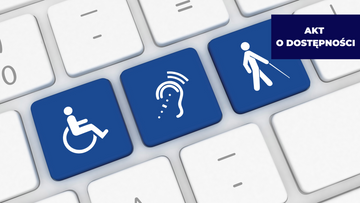Legal aspects of providing SaaS services – what documents should be prepared?
by Marcin Tomczak on Apr 16, 2024
Both the market importance and value of SaaS applications have been growing significantly in recent years. All indications are that these figures will continue to soar. This is the perfect time to implement your ideas, but how can you properly secure your application to avoid legal complications? We've got some advice!
Is there SaaS?
SaaS stands for Software as a Service, which involves remotely providing software over the Internet. The development of SaaS has contributed to removing barriers related to location – we are no longer limited to devices with a given application installed or to an office network. Thanks to SaaS, we can use a given application from anywhere in the world, as long as we have internet access.
Simplicity, guaranteed security, the ability to immediately use the application without having to purchase servers and software, access to the current version, and the ability to use the application via a standard web browser make this service increasingly appreciated – and these are just some of the many benefits of this model.
Documentation – a necessity or unnecessary paperwork?
Creating a SaaS application is a significant challenge, but there are still many tasks to complete before making the software available to users. One more crucial step remains to be completed to achieve success: preparing the documentation. Properly prepared documentation is the icing on the cake in this process – it helps you ensure a secure and stable income while minimizing the risk of customer misunderstandings and additional costs.
What needs to be prepared?
- Regulations as a service provision agreement
As the name suggests, providing software in a SaaS model constitutes the provision of a service. It's a service provided electronically, and therefore subject to a range of regulations: from the Civil Code, through the Act on Providing Services by Electronic Means, to the GDPR. Therefore, it's necessary to prepare detailed regulations that comprehensively address issues related to software provision. You might be under the impression that regulations are a formality that simply needs to be checked off a checklist because, after all, no one reads them.
Nothing could be further from the truth.
Well-drafted terms and conditions for software provided in a SaaS model not only guarantee financial benefits for the developer but also prevent user abuse and potential legal issues. By defining the terms and conditions of service, you can limit your liability and regulate issues related to contract termination.
What should you keep in mind when drafting SaaS regulations? Check out the checklist!
☑ Service Description – Clarify how the app you offer will function. The devil is in the details – the more precise you are, the less chance you have of not only avoiding misunderstandings with customers but also of people who are unfamiliar with this type of digital service or have never used it before.
☑ Service Price – You can specify the price directly in the terms and conditions or include a link to the price list. This allows potential customers to easily familiarize themselves with the available payment methods and their types – in the age of growing smart shopping, price transparency is a crucial element that can have a significant impact on choosing your service.
☑ Technical terms – clearly define what the customer needs to use the service. This minimizes the risk of widespread contract termination after the first month.
☑ Terms of use of the service – here you can specify the rules for access to the application, the method of creating an account, the method of contact between you and the customer, and any other issues that are important for using the offered SaaS.
☑ License – detailed instructions can be found in point 2 of the article.
☑ Scope of the Service Provider's liability – this is the right place to protect yourself for the future and limit your liability to the extent permitted by applicable law.
☑ Service Level Agreement – a guaranteed level of service provision, which you can read more about in point 3 of the article.
- License Agreement
Every SaaS adventure should be preceded by a carefully crafted license agreement. You don't have to treat it as a separate document—it's enough to include a relevant provision in your terms and conditions.
What should a license agreement specify?
Above all, it must clearly define the rights and obligations of both parties, the scope and terms of use of the service. Failure to conclude a license agreement can lead to many undesirable consequences for both the service provider and the user – from misunderstandings regarding the scope of services, availability, or any limitations (due to maintenance, for example), to the service provider's failure to protect its intellectual property. If you don't want unfair competition to profit from your hard work, remember to license it!
- Service Level Agreement – SLA
Defining the guaranteed level of service provided is one of the key elements of the regulations or contract for customers using the application for business purposes.
What should be in it?
Availability of software provided in the SaaS model, response time to customer requests, service and maintenance work, as well as emergency procedures.
Remember, in your SLA, don't promise mountains of gold, but rather a level of service you can actually deliver. This will prevent you from incurring financial losses and reputational damage.
- Privacy Policy
The importance of privacy protection is growing, as evidenced not only by the number of current regulations on personal data protection but also by growing public awareness. Personal data protection is particularly important for consumer service users, making it the second document, alongside the terms and conditions, essential for launching a SaaS service.
What should be specified in a privacy policy? Check out the checklist!
☑ Personal data administrator;
☑ Collected and processed data;
☑ The legal basis for processing personal data;
☑ Purpose of data processing;
☑ Information about entities to which data is transferred;
☑ Rights of persons whose data are processed;
☑ Cookie Policy.
Speaking of personal data…
- Personal data processing entrustment agreement
If the service recipient is to provide the service provider with personal data, the service provider will process them in connection with the provision of the SaaS service to the service recipient and on his behalf.
Complicated? Do you know how to handle it? The answer is simple: sign a personal data processing agreement (or include it in your terms and conditions). What should such an agreement specify?
☑ Subject of the contract – i.e. the scope, type of data entrusted for processing and the time of their processing;
☑ the category of persons whose personal data is being processed;
☑ purpose of data processing;
☑ obligations and rights of the personal data controller;
☑ obligations of the entity that will process personal data for the purpose of performing the contract.
When it comes to personal data, the service provider's obligations do not end there!
It is also necessary to maintain documentation of personal data processing. This obligation arises from Regulation (EU) 2016/679 of the European Parliament and of the Council of 27 April 2016 on the protection of natural persons with regard to the processing of personal data and on the free movement of such data, and repealing Directive 95/46/EC, also known as the GDPR.
What documentation should be kept, among other things? (This is the last checklist!)
☑ processing activities;
☑ categories of processing activities;
☑ personal data protection violations;
☑ alarm procedure, i.e. how to deal with personal data protection breaches;
☑ procedures for considering customer and user requests for access to data, copies of data, the right to be forgotten and others;
☑ procedures for providing documentation;
☑ principles of working in IT systems
☑ in the field of security policy.
Summary
Implementing a SaaS application requires careful preparation, not only technically but also formally. Professional legal documentation forms the foundation of a stable and secure relationship between the service provider and the client, protecting both parties from legal and business issues and potential disputes.
The amount of documents that need to be prepared and the documentation that needs to be kept up to date can be overwhelming even for experienced SaaS developers.
If you want the documentation related to the software you offer in the SaaS model not to resemble a folder with random documents, like a bunch of Sa(a)Sa to Las, use the help of a specialized team of lawyers who know the realities of the IT industry well.
We know how important time is in your case, so we begin working on your case within 24 hours of contact. IT requires entrepreneurs to make bold, yet quick, decisions, so the ability to stay in constant contact with lawyers is invaluable in running a business.
If you're planning to implement your own SaaS application or want to verify whether your SaaS business complies with legal requirements, contact us at this address. At ecommerce.legal , efficiency meets real-world legal and business experience , making your business more attractive and adaptable to the dynamic world of IT law.





